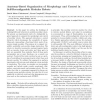Free Online Productivity Tools
i2Speak
i2Symbol
i2OCR
iTex2Img
iWeb2Print
iWeb2Shot
i2Type
iPdf2Split
iPdf2Merge
i2Bopomofo
i2Arabic
i2Style
i2Image
i2PDF
iLatex2Rtf
Sci2ools
NCA
2010
IEEE
2010
IEEE
Anatomy-based organization of morphology and control in self-reconfigurable modular robots
In this paper we address the challenge of realizing full-body behaviors in scalable modular robots. We present an experimental study of a biologically inspired approach to organize the morphology and control of modular robots. The approach introduces a nested hierarchy which decomposes the complexity of assembling and commanding a functional robot made of numerous simple modules. The purpose is to support ver, scalability, and provide design abstraction. The robots we describe incorporate anatomy-inspired parts such as muscles, bones and joints, and these parts in turn are assembled from modules. Each of those parts encapsulates one or more functions, e.g. a muscle can contract. Control of the robot can then be cast as a problem of controlling its anatomical parts rather than each discrete module. To validate this approach we perform experiments with micron-scale spherical catom modules in simulation. The robots we simulate are increasingly complex and include snake, crawler, quadruped...
| Added | 20 May 2011 |
| Updated | 20 May 2011 |
| Type | Journal |
| Year | 2010 |
| Where | NCA |
| Authors | David Johan Christensen, Jason Campbell, Kasper Støy |
Comments (0)

